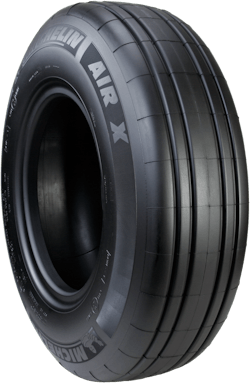Tread Lightly
From starting as a small rubber factory in Clermont-Ferrand, France in 1889, Michelin is now a full-service tire manufacturer supplying the needs of military, airline, regional and general aviation segments. With safety as their number one priority, Michelin continues to improve tires with advancements in longer-wearing tread technology.
“Michelin has earned wide recognition for aircraft excellence through pioneering product developments and outstanding manufacturing quality,” said Jim Boyle, Michelin aircraft tire safety expert.
Safety is the number one priority in aviation due to the inherent severity of aircraft tire operations and the concern of large numbers of passengers involved in the critical business of aviation. Aircraft tires are exposed to extreme speeds, loads, temperatures and pressures during all phases of use. Unlike passenger car tires that need grooves to evacuate water, aircraft tires can be worn down to the bottom of the grooves with minimal loss of performance.
“When designing aircraft tires, Michelin focuses on operational safety and increased tire performance,” Boyle mentioned. “This is achieved most often by making minor changes to tread compounds and tire construction. These are rarely visible to the human eye, but the impact can be great.”
Michelin manufactures bias and radial tires while continuing to pioneer advancements in aircraft tire technology, which results in longer-wearing tread compounds, lighter-weight tires and significant improvements in landings per tread. All while keeping in the mind their customers’ wants and needs to help improve real-time tire pressure data. “These advancements have helped provide our customers with safe operations, reduced maintenance costs, fuel savings and increased load-carrying capacity,” Boyle added.
All tires require proper attention and handling, and specifically aircraft tires due to the extreme loads and high pressures. **Aircraft tires should be inspected daily or before the first flight of the day if used infrequently. “Specific pressure requirements, inspection criteria and removal recommendations can be found in the Aircraft Maintenance Manuals (AMM) and Michelin’s Aircraft Care & Service Manual,” Boyle explained.
Maintaining proper tire pressure is not only critical for safety but increases longevity and improves tire performance. A tire on an aircraft that is found to be 10 percent under-inflated will normally require replacement because of unknown internal damages which are not visible during inspection. “Additionally, when approaching tires with unknown conditions, you should always do so from an oblique angle,” Boyle included.
“Aviation tire and wheel assemblies are permitted to decrease pressure up to five percent in a 24-hour period, but 1-2 percent is the normal rate of air loss, therefore checking pressure regularly is imperative,” Boyle said. **Most aircraft tires require venting of internal gases which may become trapped within the tire’s structure because of the high pressures involved. “This is accomplished by placing small holes in the lower sidewall of the tires. Many users have been concerned with the appearance of ‘bubbles’ in this region, but this is a normal, required occurrence with aircraft tires. All tires vent continuously and, therefore, must be regularly maintained,” Boyle said.
Aircraft tires should be handled with the same amount of care as any other highly-pressurized vessel and must be inflated utilizing a proper safety cage. “As an additional safety measure, most aircraft tires are pressurized with nitrogen because it is inert and provides a deterrent to combustion,” Boyle mentioned.
While there is no shelf-life limit for aircraft tires, to prevent degradation of the tire components, they should be stored in a cool, dark environment to reduce exposure to ozone damage. **
One of the most important things to keep in mind is to thoroughly inspect the tires before placing in service and they should not be stored for greater than 12 months without re-inspection
To keep up with all the maintenance requirements for aircraft tires, the Michelin team provides training on all levels of operations: pilots, technicians, engineers, procurement, airframes, government entities and more. “This training is provided through several platforms such as on-site seminars, aircraft user conventions, Technical Conferences and online digital content,” Boyle added.
Tires are an important component in aviation, therefore technicians must stay up-to-date on all the latest maintenance requirements, proper training and trends that are continually evolving.
“The trend for tires continues to be driven more toward radial products over bias due to several factors, including fuel savings from reduced tire weight, durability and maintenance improvements, all without sacrificing safety. For instance, a radial Michelin tire typically provides 15 percent weight savings, 60 percent to 100 percent more landings and a 50 percent decrease in FOD removals over a comparable bias tire.”
Michelin has recently launched a new General Aviation tire line—Michelin Pilot, optimized for piston, turboprop and private jets. For more tire safety information, please refer to aircraft.michelin.com or load the new Michelin aircraft app.




